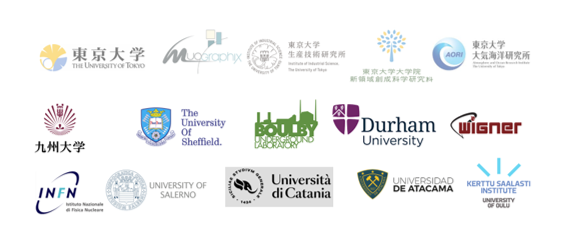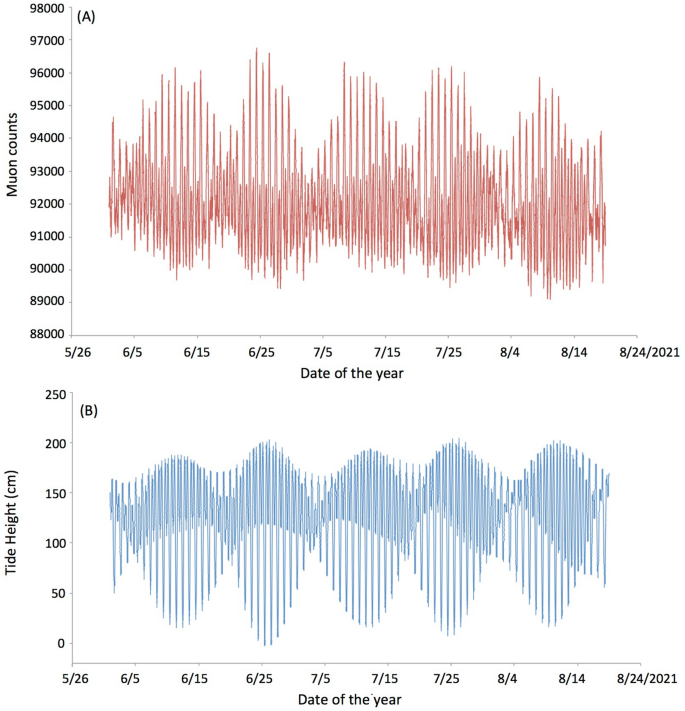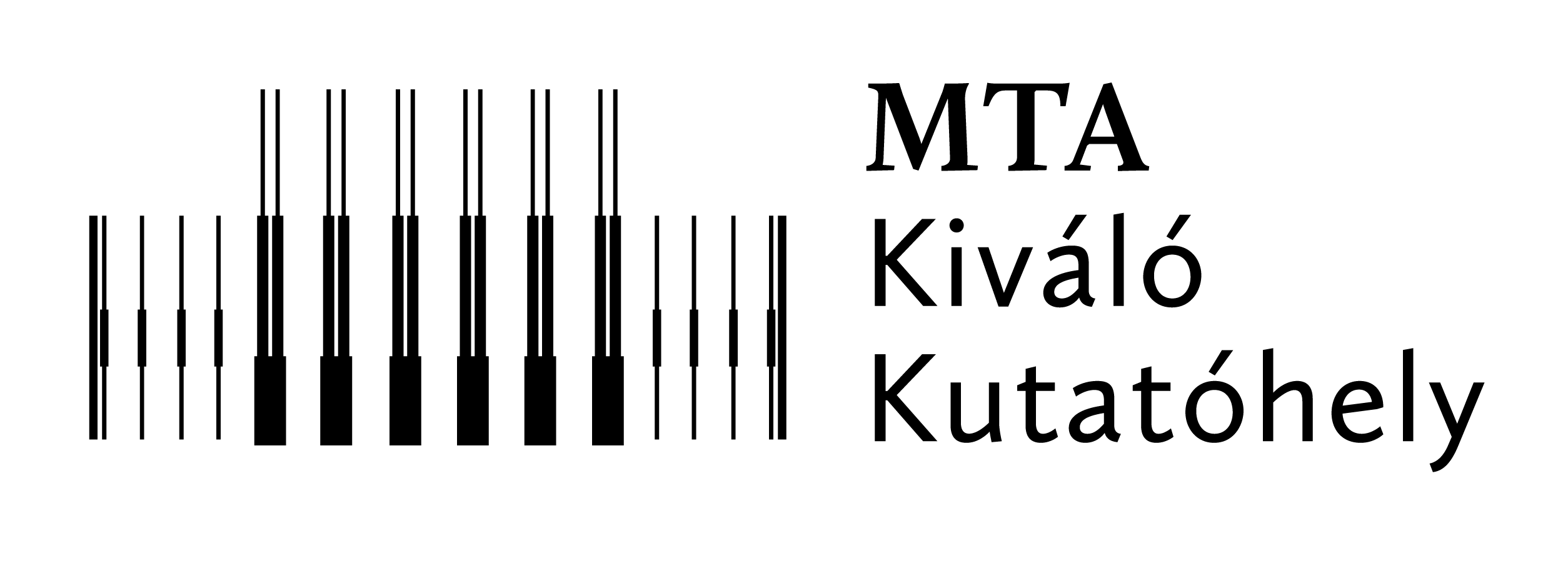
1. Release Highlights
Located in the Tokyo Bay Aqualine Submarine Tunnel near Tokyo, Japan, HKMSDD (Hyper KiloMetric Submarine Deep Detector) (Note 1), is the world's first undersea muographic array and it has recently achieved the highest accuracy ever recorded for muography based on the comparison between the astronomical tides and the data acquired from its long stable operation for 79 days from June 1, 2021 to August 18, 2021: with a 99.7 percent accuracy per 2 hours and 99.85 percent accuracy per lunar day (24 hours 50 minutes); in contrast, the best levels of accuracy on land achieved before for the same kind of measurement with the same time scale couldn't reach values higher than 99 percent.
- While muography (Note 2) has successfully been proven to be a method to image the internal structures of large, solid bodies such as volcanoes, nuclear reactors, and pyramids, time-dependent changes with an accuracy of higher than 99 percent had not been possible until now. This new achievement in underwater muography has set a new standard that improves the previous accuracy by an order of magnitude.
- This improved accuracy has widened the scope of how HKMSDD can be utilized; for example, imaging and close to real-time monitoring of seismic and meteorological tsunamis as well as the ocean seafloor will be possible.
- There are future plans to mount a HKMSDD in a pressure-resistant container to directly install to a region of deep ocean seafloor. It is anticipated that eventually targets such as submarine volcanoes, oceanic crust and practical applications such as monitoring carbon capture and storage will be imaged with muography.
2. Release summary
University of Tokyo International Muography Research Organization has installed the world's first undersea muographic array called HKMSDD (Hyper KiloMetric Submarine Deep Detector) in collaboration with University of Tokyo Institute for Industrial Science, University of Tokyo Graduate School of Frontier Sciences, University of Tokyo Atmosphere and Ocean Research Institute, Kyushu University, University of Sheffield, Durham University, STFC Boulby Underground Laboratory, Istituto Nazionale di Fisica Nucleare, University of Salerno, Wigner Research Centre for Physics, Atacama University, and Oulu University Kerttu Saalasti Institute. After 79 consecutive days of operation, June 1, 2021 to August 18, 2021, Tokyo-bay HKMSDD (TS-HKMSDD) successfully collected astronomical tide data for the purpose of evaluating accuracy. By comparing these muographic data with the astronomical tide data, it was confirmed that a 99.7 percent accuracy per 2 hours and 99.85 percent accuracy per lunar day (24 hours 50 minutes) had been achieved by HKMSDD.
Muography is similar in principle to x-ray imagery in that it can be utilized for non-invasive, internal imaging, and it utilizes the characteristics of the cosmic-ray muon (Note 2) to act as a probe. Muography has successfully been proven to be a practical method to image the internal structures of large, solid bodies such as volcanoes, nuclear reactors, and pyramids; however, because of previously mentioned limitations of accuracy of less than 99 percent, very small time-dependent changes had been difficult to monitor. Underwater muography has set a new standard that improves the previous accuracy by an order of magnitude and makes more precise time-dependent change monitoring possible.
This improved accuracy has widened the scope of how HKMSDD can be utilized; for example, new experiments have already started to apply this improved accuracy to experiments that have started to track the movements and development of storms like tsunamis and bathymetric/seafloor topographic variations above this muographic array. There are also plans to begin monitoring 2 new targets in Tokyo Bay: 1. the sediment structure and 2. greenhouse gas (methane) deposits within the seafloor. Moreover, there are future plans to mount a HKMSDD in a pressure-resistant container to directly install onto/underneath a region of deep ocean seafloor. It is anticipated that eventually targets such as submarine volcanoes, oceanic crust and practical applications such as monitoring carbon capture and storage will be imaged and monitored with muography.
3. Release content
Highest Recorded Observation Accuracy for Muography. After being accelerated by galactic high-energy events such as supernova explosions, galactic cosmic rays travel vast distances before interacting with the Earth’s atmosphere and generating the elementary particles called muons. These are the particles which are utilized as probes in muography. Muons are mainly generated in the uppermost troposphere, but their attenuation changes according to local changes in atmospheric pressure by the time they reach the surface of Earth. Muographic observations on land are affected by changes in atmospheric pressure over time, making it extremely difficult to capture changes in density below 1 percent.
Muons have strong penetrating power, and after passing through the seawater of Tokyo Bay, they continue to travel through the bedrock of the seafloor prior to reaching the detectors, which are installed inside the section of the Tokyo Bay Aqua-line tunnel lying under the seawater and seafloor. By detecting, counting and mapping out each muon rate, it is possible to measure the thickness of seawater above HKMSDD. In other words, the time-dependent changes in sea level can be captured (Figures 1 to 3). Conversely, it is also possible to verify the observation accuracy of seafloor muography by comparing the muography data with reliable sea-level data from other sources. Also, the time resolution, spatial resolution, and measurement range of muography measurements are improved by increasing the number of muographic modules installed in the tunnel.
There are advantages to conducting muography in facilities under the seafloor, since in these regions the temporal variations of muon flux are compensated by the "inverse barometric effect (IBE) (Note 4)" of the seawater located above HKMSDD. This is how the observation accuracy of 99.7 percent per 2 hours (99.85 percent accuracy per lunar day) was achieved, an order of magnitude improvement from what could be achieved with the conventional land-based muography. As a result, the highest accuracy ever recorded for muography has been achieved. Here, the former 99.7 percent was derived by calculating the standard deviation from the verified variations of astronomical tide level data, and the latter 99.85 percent was derived by calculating the standard deviation of the fluctuation with the assumption that the sea level did not fluctuate in Lunar day units.


Figure 1:Photograph of Tokyo Bay Aqua-line and the location of TS-HKMSDD
© 2021 Hiroyuki K.M. Tanaka/Muographix
The label Mu indicates the location of TS-HKMSDD.

Figure 2: Measurement results by TS-HKMSDD
© 2021 Hiroyuki K.M. Tanaka/Muographix
The red line (A) is the muon count measured by TS-HKMSDD, and the blue line (B) is the astronomical tide level.

Figure 3: Time variation of tide level by TS-HKMSDD (A) and difference from astronomical tide level (B)
© 2021 Hiroyuki K.M. Tanaka/Muographix
Future Prospects. By utilizing HKMSDD to measure various ocean environments and regions below the seafloor worldwide, researchers will have high-precision data to monitor global trends of phenomenon such as severe weather patterns and tsunamis caused by tropic cyclones and earthquakes, and bathymetric/seafloor topographic variations such as seafloor dune migration. Furthermore, it will be useful for monitoring factors which are more localized such as changes in seawater density from ocean dynamics, submarine volcanoes and evaluating the South Kanto gas field (Note 5) located underneath the seafloor of Tokyo Bay; by scientifically elucidating the mechanism of methane movement and accumulation in the shallow sedimentary layer of Tokyo Bay and the spatial distribution and scale of shallow gas reservoirs using muography technology, one source of greenhouse gas emissions in the Tokyo Bay area could be evaluated and monitored. This example shows how muography monitoring could contribute to understanding risks and ensuring safety in underground development.
Furthermore, by utilizing TS-HKMSDD, we aim to develop muography technology that can be applied to time sequential environmental monitoring of density changes of substances such as gas, fluid, and magma within the seafloor bedrock. In the future, by putting HKMSDD in a pressure-resistant container to move to deep ocean seafloor locations carbon capture and storage (CCS) monitoring (Note 6) and submarine volcanoes, for instance, could be monitored.
4. Contact
Professor Hiroyuki K.M. Tanaka
Director, International Muography Collaborative Research Organization,
The University of Tokyo
1-1-1, Yayoi, Bunkyo-ku, Tokyo 113-0032
Email: ht"at"muographix.u-tokyo.ac.jp
ht"at"eri.u-tokyo.ac.jp
ht"at"virtual-muography-institute.org
International Muography Research Organization Website:
https://www.muographix.u-tokyo.ac.jp/
5. Journal information
Journal title: Scientific Reports
Article title: First results of undersea muography with the Tokyo-Bay Seafloor Hyper-Kilometric Submarine Deep Detector. Sci Rep 11, 19485 (2021).
Authors:Hiroyuki K. M. Tanaka*, Masaatsu Aichi, Cristiano Bozza, Rosa Coniglione, Jon Gluyas, Naoto Hayashi, Marko Holma, Osamu Kamoshida, Yasuhiro Kato, Tadahiro Kin, Pasi Kuusiniemi, Giovanni Leone, Domenico Lo Presti, Jun Matsushima, Hideaki Miyamoto, Hirohisa Mori, Yukihiro Nomura, László Oláh, Sara Steigerwald, Kenji Shimazoe, Kenji Sumiya, Hiroyuki Takahashi, Lee F. Thompson, Yusuke Yokota, Sean Paling & Dezső Varga
DOI:https://doi.org/10.1038/s41598-021-98559-8
Abstract URL:https://www.nature.com/articles/s41598-021-98559-8
6. Glossary
(Note 1) Tokyo Bay Seafloor Hyper KiloMetric Submarine Deep Detector (TS-HKMSDD): Muographic modules that can detect elementary particle muons (Note 3) are arranged at regular intervals. Whenever a muon is detected, a signal is collected and recorded at a data acquisition center located in the center of the TS-HKMSDD. TS-HKMSDD was installed inside the Tokyo Bay Aqua-Line undersea tunnel (over 100 meters long), but further expansion and installation of new muographic arrays are planned in Tokyo Bay as well as in locations worldwide, such as the North Sea the British-French Strait, and the Gulf of Finland.
(Note 2) Muography: Similar to x-ray technology, muography takes advantage of the strong penetration of cosmic-ray muons (Note 3) (high energy muons can travel through 1 km or more on rock before decaying), and has been utilized for imaging the internal structure of gigantic objects on land. X-rays generate medical radiographic images, which utilizes the fact that the most x-rays can travel through the soft tissue within a human body without interacting and decaying. Due to the penetration power of high energy muons, they can travel through deep seawater and beyond without interacting and decaying, therefore it is possible to create images with this method (similar to X-ray photographs) to discover, for example, the density distribution and/or depth of the ocean and seafloor using muography.
(Note 3) Cosmic-ray muon: When particles called cosmic rays, which are accelerated to nearly the speed of light by high-energy events (such as supernovae) reach Earth, they react with the atomic nuclei of nitrogen and oxygen that make up the atmosphere to generate high-energy secondary particles. One of these generated particles is an elementary particle called the muon, which has strong penetrating power.
(Note 4) Inverse barometric effect (IBE): At the center of a cyclone, the air pressure is lower than the surrounding area, so the air near the center will suck up seawater, resulting in a rise in sea level. On the contrary, high-pressure air pushes down seawater. Therefore, the time-dependent variations of muon flux caused by the barometric pressure fluctuation are mostly compensated by these variations in sea levels. On the other hand, due to the difference in Z / A (Z is the atomic number and A is the atomic weight) in the nuclei that make up the atmosphere and seawater, seawater is slightly more difficult for muons to pass through even at the same surface density. Therefore, the change in muon flux due to atmospheric pressure change is not completely canceled out by the change in muon flux due to sea level change.
(Note 5) South Kanto gas field: This is a water-soluble natural gas field consisting of methane gas of microbial origin that spans Ibaraki, Saitama, Tokyo, and Kanagawa prefectures, but the main bulk of this field is located in Chiba prefecture. Energy development started before the 1940s, and there was a time when gas wells were excavated and natural gas was produced in Tokyo, but now this commercial activity happens only in Chiba prefecture. However, since this gas field underneath Tokyo Bay has not been sufficiently surveyed yet, the extent of the gas reserves existing this area remains unclear.
(Note 6) Carbon capture and storage (CCS): Currently, the International Energy Agency (IEA) Energy Technology Outlook (ETP2017) states that 16% of cumulative carbon dioxide emissions as of 2060 will be channeled into carbon capture and storage (CCS) as a measure to mitigate global warming by reducing carbon dioxide emissions. In order to reach this goal, constant monitoring and evaluation of the integrity of the storage units containing the injected CO2 will be required and therefore, technological development of a muography monitoring system should happen in tandem with related development of CO2 separation, capture, and storage methods.



